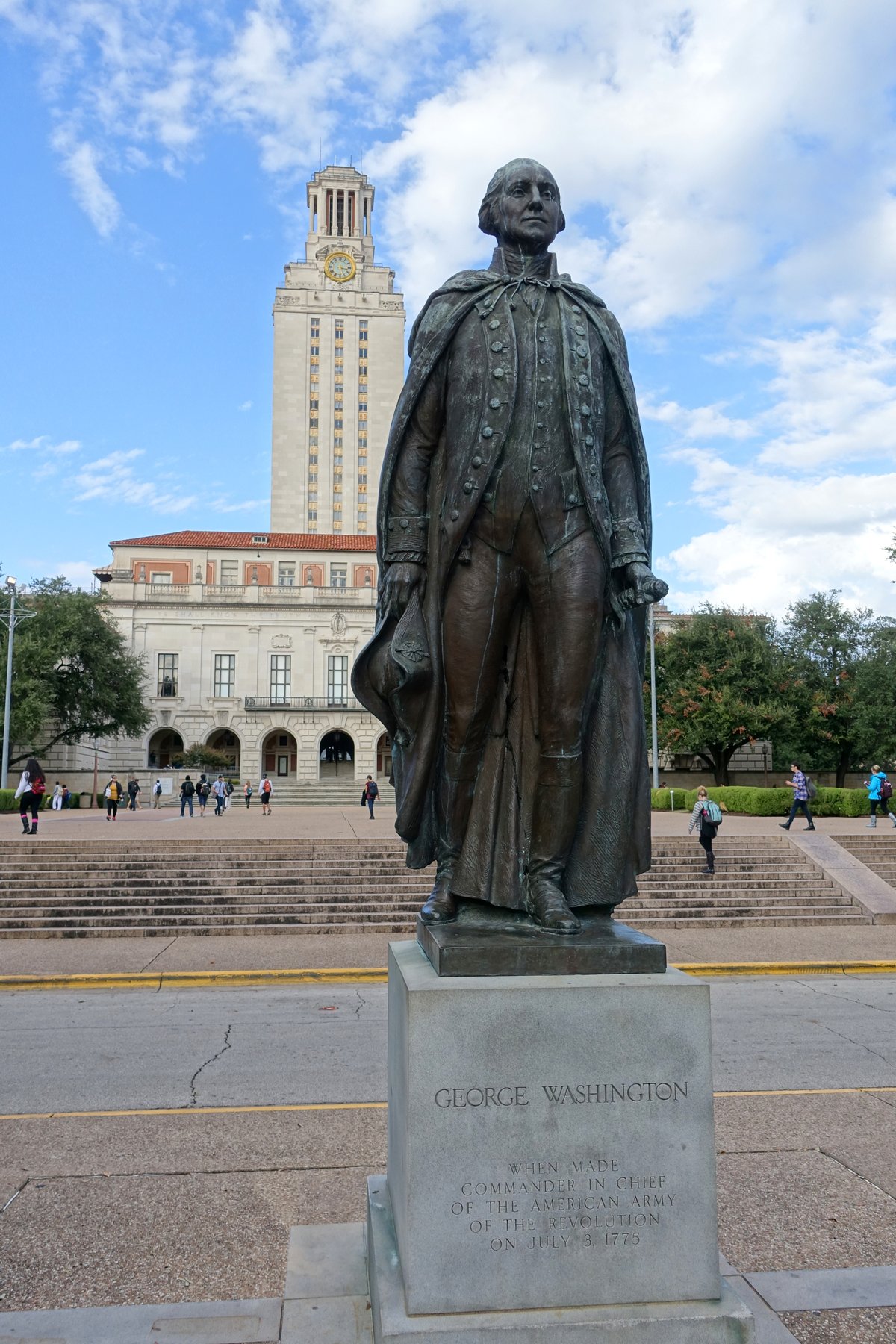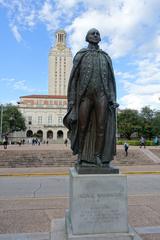
George Washington Statue Austin Texas: Visiting Hours, Tickets, and Historical Significance
Date: 14/06/2025
Introduction
Austin, Texas, is renowned for its historical landmarks that reflect America’s evolving heritage and cultural narratives. Among the most prominent are the George Washington statues—particularly those at the University of Texas at Austin (UT Austin) and on the Texas State Capitol grounds. These monuments serve as enduring reminders of the nation’s founding ideals, while also inviting reflection on the complexities of public memory and historical representation. Complementing these sites is the George Washington Carver Museum, a cornerstone institution for African American history and culture in East Austin. This comprehensive guide explores the history, significance, visitor information, and nearby attractions for these landmarks, equipping travelers, history enthusiasts, and locals with essential details for an enriching visit (Waymarking; Smarthistory; Austin Texas Official Tourism; Austinot).
Contents
- Introduction
- George Washington Statue at UT Austin
- History & Artistic Background
- Visiting Hours & Accessibility
- Tours, Photography, and Nearby Attractions
- FAQs
- George Washington Statue at Texas State Capitol
- Historical Context & Placement
- Symbolism & Representation
- Visiting Hours, Accessibility, and Tours
- FAQs
- George Washington Carver Museum
- Cultural Importance & Exhibits
- Visiting Hours, Tours, and Accessibility
- Educational Programming & Community Impact
- FAQs
- Summary and Additional Resources
- References
George Washington Statue at UT Austin
History & Artistic Background
Erected in 1955, the full-length bronze statue of George Washington on the UT Austin campus was sculpted by Pompeo Coppini, a notable Italian American artist. Commissioned by the Texas Society Daughters of the American Revolution (DAR), the statue honors Washington’s foundational role in American independence (Waymarking).
Coppini’s design features Washington in military uniform, underscoring his leadership as Commander in Chief during the American Revolution. A distinctive element is the cane capped with a lion’s head, symbolizing Britain—a subtle artistic critique of colonial rule (Flickr).
The statue’s installation on the South Mall followed the placement of several Confederate monuments, many funded by Major George Washington Littlefield. In contrast, the Washington statue was intended as a symbol of national unity. Following the removal of Confederate statues in 2016, it now stands alone, further emphasizing its role in campus history (Austin Chronicle; Racial Geography Tour).
Visiting Hours & Accessibility
- Hours: The statue is in an open area and accessible daily from dawn until dusk.
- Tickets: No admission or ticket is required.
- Accessibility: Paved and wheelchair-friendly pathways lead to the statue. Accessible parking is available nearby.
Tours, Photography, and Nearby Attractions
- Guided Tours: UT Austin offers campus tours that include the statue. These can be booked via the university’s visitor center.
- Photography: The statue, framed by the UT Tower, makes for striking photographs—especially at sunrise or sunset (Austinot).
- Nearby Sites:
- Littlefield Fountain – Another Coppini work and a major campus landmark.
- UT Tower and Main Building – Iconic architecture with observation decks.
- Blanton Museum of Art and LBJ Presidential Library – Both offer enriching cultural experiences.
Travel Tip: Use public transportation or campus shuttles to avoid parking hassles. Wear comfortable shoes and bring water during warmer months.
Frequently Asked Questions (FAQ)
- Q: Are tickets required to visit?
- A: No, the site is free and open to the public.
- Q: When is the best time for photography?
- A: Early morning or late afternoon for optimal lighting.
- Q: Is the site accessible for those with disabilities?
- A: Yes, paved and ramped walkways surround the statue.
- Q: Are guided tours available?
- A: Yes, through UT Austin’s visitor center.
George Washington Statue at Texas State Capitol
Historical Context & Placement
The Capitol’s George Washington statue is part of a broader tradition of honoring America’s founders in civic spaces. Its placement among Texas historical monuments highlights the state’s alignment with national narratives of leadership and republican values (Smarthistory).
Erected in the early 20th century, the statue reflects the era’s efforts to reinforce patriotism and collective identity. Its position near memorials such as the Texas African American History Memorial invites reflection on the contradictions and complexities of American history (Visit Austin).
Symbolism & Representation
Drawing inspiration from Jean-Antoine Houdon’s acclaimed statue, the Austin representation depicts Washington in contemporary attire rather than neoclassical costume, emphasizing his civilian and military leadership (Smarthistory). Its proximity to other monuments sparks dialogue on inclusion, representation, and the evolving meaning of public memory.
Visiting Hours, Accessibility, and Tours
- Hours: Capitol grounds are typically open from 8:00 AM to 8:00 PM daily.
- Tickets: No fees or tickets required.
- Accessibility: Paved, wheelchair-accessible paths; accessible restrooms nearby.
- Tours: The Texas State Preservation Board and local organizations offer guided tours of the grounds and monuments.
Visitor Tip: Check the official Capitol website for tour schedules and information on special events.
Frequently Asked Questions (FAQ)
- Q: What are the visiting hours?
- A: 8:00 AM–8:00 PM daily, subject to change for holidays/events.
- Q: Is admission free?
- A: Yes, there is no charge to visit the statue or Capitol grounds.
- Q: Is the site wheelchair accessible?
- A: Yes, pathways and restrooms are accessible.
- Q: Are guided tours available?
- A: Yes, check the State Preservation Board’s website for details.
George Washington Carver Museum: Hours, Tickets, and Cultural Highlights
Cultural Importance & Exhibits
Located in East Austin, the George Washington Carver Museum and Cultural Center is dedicated to celebrating and preserving African American history. Housed in a building listed on the National Register of Historic Places, the museum offers four permanent galleries and rotating exhibitions, including “The African American Presence in 19th Century Texas,” the Families Gallery, and an exhibit on L.C. Anderson High School (Wikipedia).
Visiting Hours, Tours, and Accessibility
- Hours: Tuesday–Saturday: 10:00 AM–5:00 PM; Sunday: 1:00 PM–5:00 PM; closed Mondays/major holidays.
- Admission: Free for all visitors.
- Tours: Guided tours and special programs are available with advance registration. Check the museum website for details.
- Accessibility: The museum is fully ADA accessible.
Educational Programming & Community Impact
The museum’s educational mission includes interactive exhibits, hands-on art workshops, film screenings, artist lectures, and annual events such as Juneteenth commemorations. The Juneteenth Memorial Monument is a centerpiece of the outdoor space, marking the story of emancipation through art. The Carver Genealogy Center offers resources and classes for tracing African American ancestry, empowering individuals to explore and document their family histories.
By centering Black narratives and promoting community engagement, the museum fosters pride, learning, and dialogue around social justice and representation (Texas Architect; Travel Noire).
Frequently Asked Questions (FAQ)
- Q: What are the museum’s hours?
- A: Tues–Sat: 10 AM–5 PM; Sun: 1–5 PM; closed Mondays and holidays.
- Q: Is admission free?
- A: Yes, general admission is always free.
- Q: Are tours available?
- A: Yes, for special programs and groups; see the museum website for info.
- Q: Is the museum accessible?
- A: Yes, it is fully ADA accessible.
Summary and Additional Resources
The George Washington statues and the George Washington Carver Museum together offer a multidimensional experience of Austin’s historical, artistic, and cultural landscape. From Coppini’s evocative sculpture at UT Austin to the thought-provoking memorials at the Capitol and the Carver Museum’s role in celebrating African American heritage, each site invites deeper engagement with America’s past and its present-day relevance. These landmarks are accessible, educational, and welcoming—with free admission, inclusive amenities, and robust programming.
For a richer experience, leverage self-guided tours, join campus or Capitol walks, and attend community events. Download the Audiala app for interactive maps and up-to-date information. Follow all official channels for news, events, and visitor tips.
References
- Statue of George Washington, University of Texas South Mall, Austin, TX, USA (Waymarking, 1955)
- Statue of George Washington (Austin, Texas) (Wikipedia)
- Written in Stone: Austin’s Monuments and Memory (Austin Chronicle, 2015)
- Houdon’s George Washington Statue and its Legacy (Smarthistory)
- African American Landmarks in Austin (Visit Austin)
- Famous Statues in Austin (Austinot)
- Five Great Artistic Landmarks at UT Austin (UT News, 2015)
- George Washington Carver Museum and Cultural Center (Austin Texas Official Tourism)
- George Washington Carver Museum and Cultural Center (Wikipedia)
- Austin Revisits Expansion Plan for Carver Museum and Cultural Center (Texas Architect, 2023)
- George Washington Carver Museum and Cultural Center Juneteenth Memorial Sculpture (Wikipedia)
- UT Austin Self-Guided Walking Tour Guide (Travel Realist)



























































